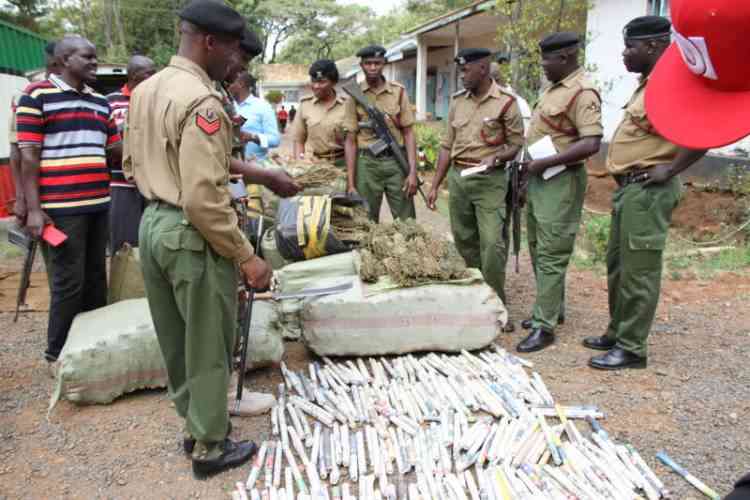 |
|
Drug addiction in schools has reached alarming levels, according to recent surveys. INSET: Nacada chairman John Mututho. |
By SYLVIA WAKHISI and DANIEL WESANGULA
National Authority for the Campaign Against Alcohol and Drug Abuse (Nacada) chairman John Mututho has demonstrated great passion in the war against drug and substance abuse.
But as Mututho briskly busts alcohol suppliers, bars and restaurants flouting licensing rules, the danger to your child could be right next to him or her. It could be the desk mate, the teacher or even your trusted green grocer.
Statistics from the anti-drugs body say up to 43 per cent of students knew of schoolmates found in possession of cigarettes. This could be your child’s best friend or, even worse, your son or daughter.
Kenneth Wameyo was an angry man. Last year, the head teacher of the school his Form One daughter attended had just called him insinuating the impossible. In her boldness, she had accused Wameyo’s daughter of the unthinkable.
“In essence, she was saying my daughter was a drug dealer and was part of a cartel that distributed bhang in school,” Wameyo told The Standard on Sunday.
Banned substance
Well, in her defence, the headmistress didn’t use the exact words but the suspension letter his 14 year-old daughter brought back home said she it all. She had been “found in possession of a banned substance which was also found in the possession of several other students” and that “the school was investigating whether she was involved in distributing it”.
It was during the two-week suspension that Wameyo got to know the extent to which his daughter – who had since birth been the apple of his eyes – abused drugs of every kind. “She downed bottles of alcohol, smoked cigarettes and bhang and I suspected she was even into harder drugs,” he says.
Unknown to him, four out of five school going children are abusing drugs without the knowledge of their parents. For Wameyo, it took a letter from a headmistress to wrap his mind around this reality. His is not an isolated case. Many parents are forever playing referee in the high stakes, at times life-ending, contest between drugs and their children. And according to Nacada, the statistics should be a cause of worry for the entire nation.
Shocking figures
According to the latest countrywide survey done in 2012 by the anti-drug agency called the Rapid Assessment Drug and Substance Abuse in Kenya, one in three students reported using one or more drugs.
The survey indicates that alcohol was the most commonly abused substance, with 36.3 per cent of students reporting a lifetime use. Miraa comes second with usage reported among 31.5 per cent of students, cigarettes were used by 20.2 per cent, bhang by 9.8 per cent, kuber (5.5 per cent), heroin (3.1 per cent), inhalants 2.7 (per cent), amphetamines/mandrax (2.6 per cent) and cocaine was used by 2.2 per cent.
But even with these stark statistics, some experts warn parents are taking little or no notice of this.
“Some of us are catalysts of these behaviours. We have increasingly adopted a lasses-faire parenting method where we think our children are old enough to make the correct life changing decisions. There is a reason why we are parents and they are children. They need firm guidance,” says counselor Eunice Kiragu.
Stay informed. Subscribe to our newsletter
In this day, however, some parents acknowledge the difficulty in policing your child’s every move. Whether the children are at home, or in school or transiting between the two, it is never easy to keep tabs on what exactly they are doing and in what company. “Parents have come to accept a lot of grey areas in their parenting… and this is where the children get loopholes to exploit,” Ms Kiragu says.
Mary Wanja is a mother of three. She says she tries her best to give the best guidance to her children but she can never be sure if it is enough. “It becomes hard as a parent to monitor your children especially if they are grown up and into their teenage years. However, as a parent with two teenage boys in high school, I try my best to monitor their progress and ensure they do not end up into habits such as abusing drugs and alcohol,” she says.
“I do not give them huge amounts of money. I only give what I feel is enough for them to sustain them till when I will be able to visit them in school as a way of ensuring that they do not easily access illegal substances. As parents, we have a big role as far as the fight against drug abuse among students is concerned,” she adds. Many boarding schools end up setting the amount of money a parent can leave behind as pocket money; a number of them requiring a minimum deposit of Sh1,000.
Money factor
Today a child can access several illicit drugs for a fraction of that amount. For instance for the price of a loaf of bread, a cheeky student can get two glasses of chang’aa.
With Sh40, another can get two rolls of bhang. For Sh300, another can access a “hit” of poor quality cocaine. Is money really the issue? Nacada says a lot more than pocket money contributes to this problem including the schools’ set up and rules and regulations. Some schools are not strict enough while others are located in environments that enable drug abuse such as near bars. Loice Noo Okello, a psychiatrist, believes the problem of underage drug abuse goes deeper than school policies.
“The fundamental thing is to address the psychological pressures the student is undergoing. Seldom would you find a student waking up and downing a whole bottle of alcohol just for fun. In almost all cases there is an underlying psychological issue,” she says.
These may include abuse, stress over school performance or the experiencing of a traumatic life episode. “For instance, children who have undergone some form of sexual abuse are more likely to develop a drugs-related disorder,” Ms Okello says. Despite the recognition of devastating effects of drugs and alcohol on students, many schools have not instituted measures to prevent the onset of alcohol and drug consumption in schools. But homes and communities where students come from have not been supportive either.
Although most schools conduct searches on opening day, most students still beat the system.
They are introduced to drugs and alcohol through many ways including peer pressure, the desire to experiment, cheap and accessible drugs and alcohol, the environment both at home and school, poor role models from parents among other factors. “We have encountered different cases of students smuggling drugs into schools. It is not something new. It does happen,” says William Ntakuka, Programme Officer at SCAD, a non-profit organisation working to help young people achieve their potential through reducing substance abuse. “Nowadays, students have devised many sophisticated ways to smuggle drugs into schools and even in other places. They hide them in places where neither teachers nor parents can suspect,” says Ntakuka.
“Students conceal alcohol and drugs in drinks, powdered milk and even detergents. Some students mix alcohol in juices by extracting some part of the juice from the bottle and pour in the alcohol such that there is a higher percentage of alcohol in the bottle. Some drugs even pass as sweets or chewing gum, some are put in the back side of the actual toothpaste and the tube carefully sealed back into its normal shape and in sanitary towels. Some students go as far as creating a hole in bar soaps and hiding the drugs in there,” explains Ntakuka.
Highly addictive drugs such as heroine and cocaine also make their way past school authorities to the students via school staff.
Investigations by The Standard on Sunday reveal that some drugs such as cocaine and bhang are stocked in margarine containers and inside torches aimed at the student market. Alcohol is also smuggled in bottles of liquid detergents. All is not, however, lost.
Gidraph Wairire, a senior lecturer in the Department of Sociology and Social Work at the University of Nairobi says to curb this menace, sources of these drugs must be identified and dealt with.
“They may be coming in from the students, touts, hawkers or the surrounding shop outlets,” says Wairire.
Wameyo should however count himself among the lucky parents who got to know of their children’s condition in good time. Others never get a chance to talk to their children and understand what drove them to drug abuse.
 The Standard Group Plc is a
multi-media organization with investments in media platforms spanning newspaper
print operations, television, radio broadcasting, digital and online services. The
Standard Group is recognized as a leading multi-media house in Kenya with a key
influence in matters of national and international interest.
The Standard Group Plc is a
multi-media organization with investments in media platforms spanning newspaper
print operations, television, radio broadcasting, digital and online services. The
Standard Group is recognized as a leading multi-media house in Kenya with a key
influence in matters of national and international interest.
 The Standard Group Plc is a
multi-media organization with investments in media platforms spanning newspaper
print operations, television, radio broadcasting, digital and online services. The
Standard Group is recognized as a leading multi-media house in Kenya with a key
influence in matters of national and international interest.
The Standard Group Plc is a
multi-media organization with investments in media platforms spanning newspaper
print operations, television, radio broadcasting, digital and online services. The
Standard Group is recognized as a leading multi-media house in Kenya with a key
influence in matters of national and international interest.










